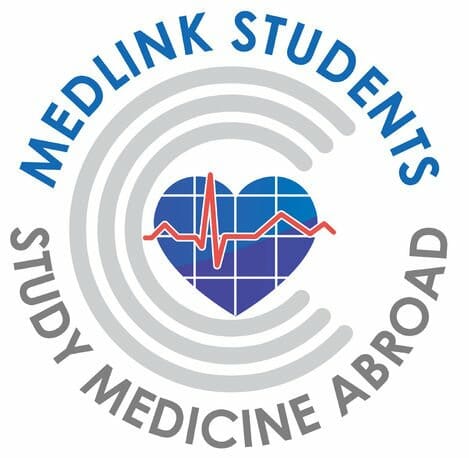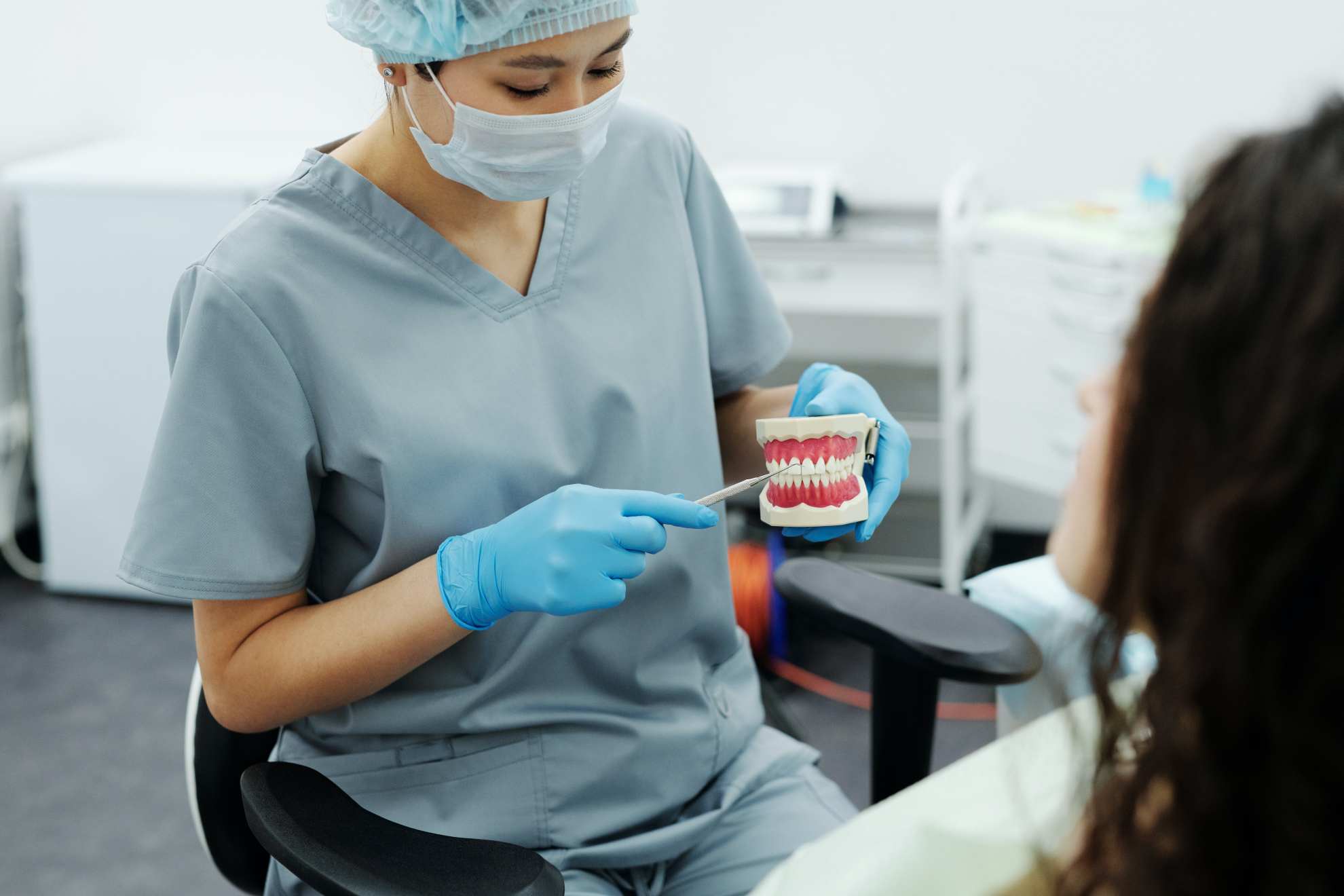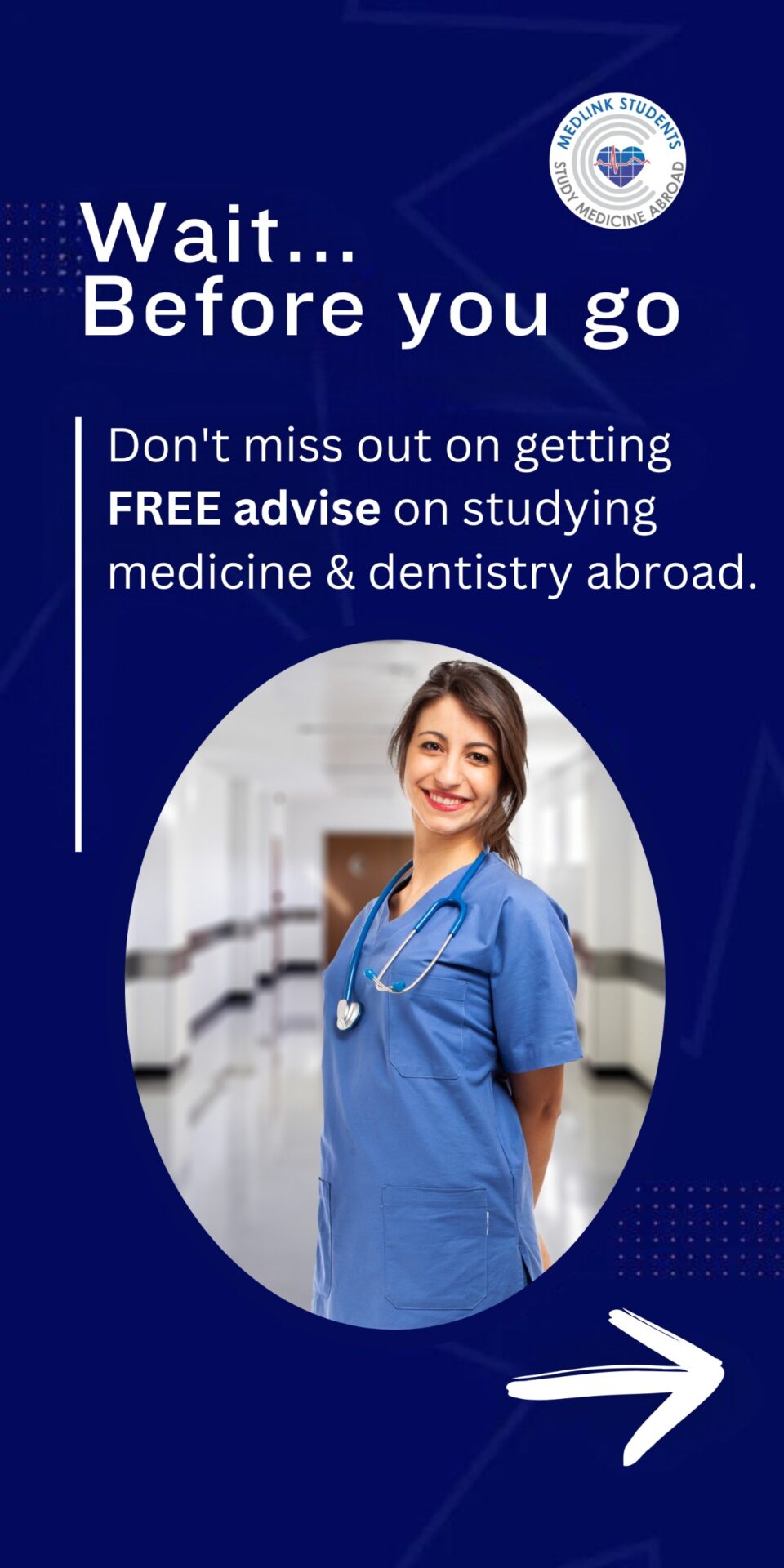Studying Medicine Abroad but Aiming for the US? The Ultimate USMLE Prep Guide

For students studying medicine abroad, becoming a doctor in the United States is a common dream.
However, there’s a key step that stands between you and this goal: the USMLE (United States Medical Licensing Examination). Whether you’re currently studying in Europe or planning to do so, understanding how the USMLE works and how to prepare for it is essential for turning your international medical degree into a successful US medical career.
In this guide, we’ll break down everything you need to know about USMLE prep if you’re studying medicine abroad - from eligibility to take the exam to study strategies, resources, and tips for success.
The key takeaways from this blog include:
- To take the USMLE, your medical school must be ECFMG-recognised and listed in the World Directory of Medical Schools.
- Choose a medical school with USMLE preparation support, clinical rotations in the US, and a curriculum aligned with US medical standards to significantly increase your chances.
- Popular USMLE prep resources include: UWorld, Pathoma, Sketchy Medical, AMBOSS, First Aid for USMLE Step 1, and Pathoma.
- USMLE Step 1 focuses on basic medical sciences, with a passing score of 196, but ideally, you should aim for 240-250 points.
- USMLE Step 2 CK evaluates clinical knowledge, with a passing score of 214 and a recommended score of 250-60. This step is crucial for securing a US residency.
- USMLE Step 3 tests your ability to practise medicine without supervision. Scoring 200 will award you a pass, and a score above 230 is considered good.
Get free advice on European medical schools and preparing for your USMLE in advance:
Check your email to Book a FREE call
with an expert advisor
Look at your promotions/spam folders, just in case.
Table of Contents
- 1 Quick USMLE Breakdown
- 2 Can You Take the USMLE If You Study Abroad?
- 3 Choosing the Right Medical School for USMLE Eligibility and Becoming a Doctor in the US
- 4 When Should You Start Your USMLE Prep?
- 5 USMLE Study Resources for IMGs/International Students
- 6 Step-by-Step USMLE Prep Guide
- 7 USMLE Pass Rates, USMLE Exam Fees & US Residency Match Rates
- 8 Why This Matters to You
- 9 Take the First Step Toward Becoming a Doctor in the US with the Student Success Programme
- 10 FAQ
- 10.1 Can I take the USMLE if I studied in Europe? Can I take the USMLE if I studied medicine abroad?
- 10.2 What is the best time to start preparing for the USMLE?
- 10.3 What USMLE score do international students need to match into a US residency?
- 10.4 Can I take clinical rotations in the US before taking the USMLE?
- 10.5 How do I register for the USMLE as an international student?
- 10.6 Which European medical schools are best for preparing for the USMLE?
- 10.7 How should I prepare for the USMLE as an international student?
Quick USMLE Breakdown
The USMLE is a 3-step exam that assesses your ability to apply medical knowledge and ensure safe patient care according to US standards. The exam is a mandatory part of becoming a doctor in the US.
The steps include:
USMLE Step 1 focuses on your understanding of basic medical sciences and your ability to apply them to the practice of medicine.
USMLE Step 2 CK (Clinical Knowledge) assesses your clinical knowledge in various medical specialities, including internal medicine, surgery, paediatrics, psychiatry, and more.
USMLE Step 3 is typically taken after you’ve completed your residency, and it evaluates your ability to treat patients in an unsupervised setting.
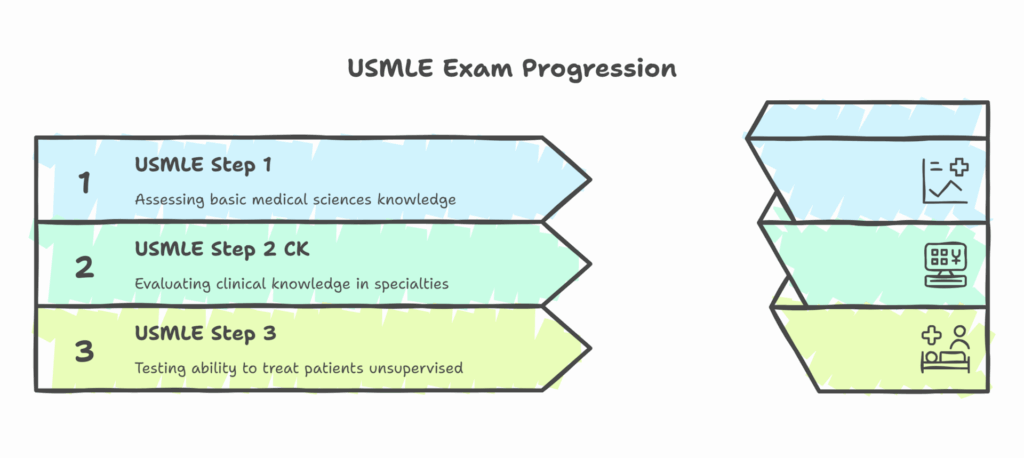

For international students, Step 1 and Step 2 CK are the most important exams and are what you should focus on the most as you prepare for the USMLE. A high score here will ensure you match into a good US residency programme, directly contributing to your progress as a doctor.
Tip: Use the early years of your medical education to build a strong base in the basic sciences and clinical subjects. This will not only help with local exams but will also prepare you well for Step 1 and Step 2 CK.
If you want an in-depth walkthrough of this exam, including USMLE steps, fees, how to register and more, feel free to read our blog: What is the USMLE?
Can You Take the USMLE If You Study Abroad?
Yes, absolutely. Many graduates from international medical schools successfully take the USMLE every year. However, there are a couple of important things to keep in mind:
1st, it’s essential to ensure that your medical school is listed in the World Directory of Medical Schools (WDOMS), and 2nd, it has to be recognised by the Educational Commission for Foreign Medical Graduates (ECFMG). If your school meets these requirements, then you cover all USMLE eligibility criteria for foreign medical graduates.
Tip: You can check the ‘Sponsor Notes’ tab when researching universities in WDOMS to see if the medical school is approved by the ECFMG and grants eligibility to take on the USMLE. Popular choices include universities like Charles University in the Czech Republic and Semmelweis University in Hungary.
Choosing the Right Medical School for USMLE Eligibility and Becoming a Doctor in the US
While there are many excellent medical schools abroad in Europe and the Caribbean, there are only a few that have exceptional support or resources to prepare you for the USMLE.
Here are the most important factors to consider when looking for your perfect match medical school:
- The programme is taught entirely in English
With the end goal of becoming a doctor in the US, it goes without saying that you should go for a medical school that offers an English-language medical programme. This ensures you’re comfortable with medical terminology and prepares you for the language used in the USMLE. - The curriculum has US compatibility
Some European and many Caribbean medical schools offer curricula that align closely with the US medical system. Studying at 1 of these will make it much easier to study for the USMLE, as you will already have a strong foundation based on the US educational model.
Standout examples include the University of Health Sciences Antigua, Ross University School of Medicine, and Texila American University. Some of these even have scholarship opportunities. - The medical school offers USMLE preparation courses
There are several European medical schools that cater specifically to students who want to go to the US and offer specialised courses to help you prepare to ace all steps of the exam. - The university offers clinical rotations in the US
Getting hands-on experience through US-based clinical rotations is one of the best ways to get familiar with the US healthcare system and prep for the USMLE. You will also be able to get a strong Letter of Recommendation for residency matching, while helping you build valuable US-based medical connections.
Tip: Picking a school that fulfils all these criteria will kickstart your journey toward becoming a successful doctor in the US.
We already have the perfect blog to help you pick a high-quality medical university with US medical practice in mind: The Top Medical Schools in Europe for Americans.
When Should You Start Your USMLE Prep?


It should be no surprise that the earlier you start, the better your chances of success. Ideally, you should begin laying the groundwork for the USMLE from Year 1 or 2 of your medical studies. Starting early allows you to build a solid foundation and avoid last-minute cramming.
Typically, in the US, USMLE Step 1 is taken after the first 2 years of study - when you complete the Basic Sciences part of the curriculum. If you’re studying medicine in Europe for US medical practice, you will be a bit more flexible and can take Step 1 as long as you’re enrolled in a medical school. Typically, though, international students also take it after completing their basic sciences phase, while the material is still fresh.
Unsurprisingly, Step 2 (Clinical Knowledge) is taken after completing your clinical rotations toward the end of your undergraduate medical degree. As always, early preparation can go a long way, and after taking a breather from completing Step 1, you should get the ball rolling on your Step 2 prep.
Step 3 is taken after graduation - when you’ve started or have already advanced your residency training. Ideally, the entirety of your medical education should serve as your foundation for passing Step 3 (independent medical practise).
Tip: Studying medicine abroad often involves a serious local exam schedule. It can be tempting to focus solely on your medical school exams, especially in the early years. However, juggling local exams with USMLE prep is key to achieving your goal of practising medicine in the US.
One way to balance both is by integrating USMLE topics into your routine. For example, when studying anatomy, focus on the areas that are tested on the USMLE. This way, you’re not doubling your effort but rather aligning your studies. You can also take advantage of free time during your breaks to do focused USMLE revision, so you're steadily progressing without disrupting your school workload.
Consider creating a study timetable that includes both to help you stay organised and ensure that you’re consistently moving towards both goals. First, we’ll share some of the top resources to help you supplement your USMLE prep, then we’ll give some example study plans you can follow.
USMLE Study Resources for IMGs/International Students
There is a wealth of study materials out there to help you prep for the exams, in addition to picking a medical school with USMLE preparation courses. However, focusing on the best and most relevant ones for international students will help you stay on track and get ahead. These include:
USMLE online preparation platforms and study tools
1. UWorld Question Bank is widely regarded as one of the best resources for Step 1, Step 2 CK, and even Step 3 preparation. Their extensive question bank is designed to mimic the actual exam format with a bit of added difficulty. Practising with UWorld helps you get familiar with the kinds of questions you'll face on test day, and the detailed explanations that accompany each question will help you improve rapidly.
2. Sketchy Medical boasts a 99.7% student success rate for passing Step 1. Sketchy uses visual mnemonics to help students retain complex information, especially in microbiology and pharmacology. The creative illustrations are effective in making hard-to-memorise topics more accessible and enjoyable.
3. AMBOSS is another popular online platform that offers interactive learning tools, a question bank, and a medical library. It’s an all-in-one resource for Step 1 and Step 2 CK, and it’s especially useful for visual learners. The platform also offers detailed clinical cases, which are great for honing clinical reasoning skills.
Best books for USMLE prep
1. First Aid for the USMLE Step 1 2024 edition (better paper quality) or 2025 edition (newest edition). This series offers a comprehensive review of all the topics tested on the exam and is 1 of the most popular guides for international students. It includes high-yield facts, mnemonics, and tips that will help you memorise essential information to ace Step 1.
2. Pathoma - Fundamentals of Pathology is another excellent resource for Step 1. The concise textbook will help you understand key concepts and high-yield material in pathology, a major subject on Step 1.
Study groups and International Medical Graduate (IMG) forums for USMLE prep
Joining local study groups and/or IMG-specific forums can make a world of difference during your exam prep. Platforms like SDN (Student Doctor Network) and Reddit can help you connect with your peers or students who have already taken the exam, so you can ask questions and exchange study tips.
Tip: Take a few USMLE practice tests from the official site to check your level and find out which areas you may be struggling with before deciding on a book or platform to go for. Don’t forget to allocate a budget, as online USMLE prep platforms can have a steep price tag.
Step-by-Step USMLE Prep Guide
USMLE Step 1 exam structure and preparation guide
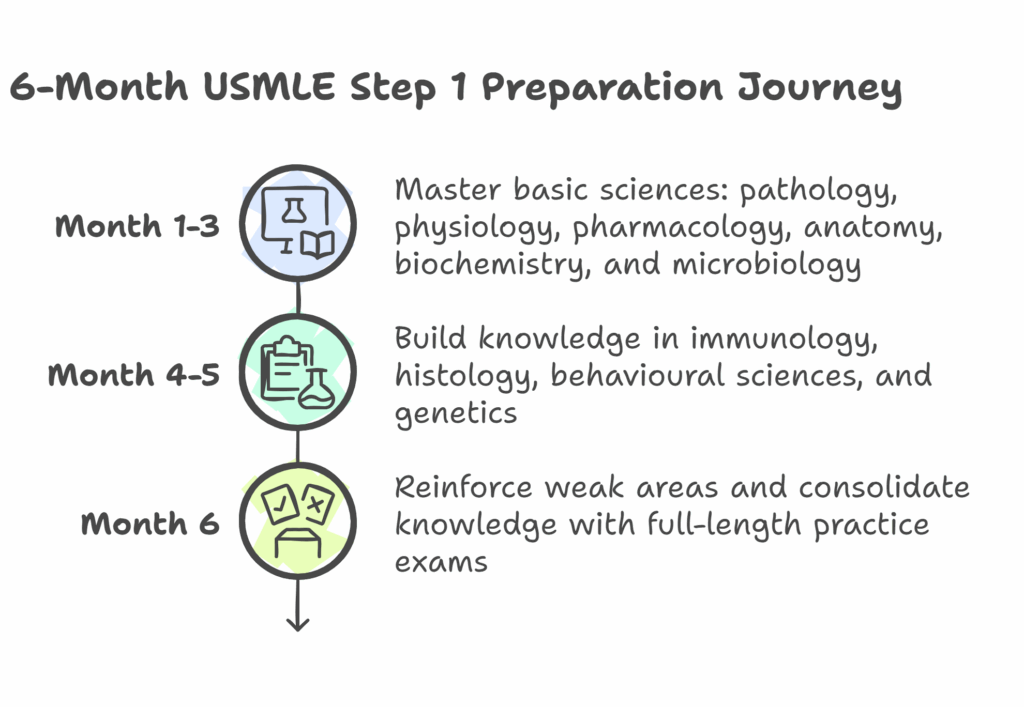

The USMLE Step 1 exam topics are as follows:
- Human Development
- Blood & Lymphoreticular/Immune Systems
- Behavioural Health & Nervous Systems/Special Senses
- Musculoskeletal, Skin & Subcutaneous Tissue
- Cardiovascular System
- Respiratory & Renal/Urinary Systems
- Gastrointestinal System
- Reproductive & Endocrine Systems
- Multisystem Processes & Disorders
- Biostatistics & Epidemiology/Population Health
- Social Sciences: Communication and Interpersonal Skills
6-month USMLE Step 1 preparation plan
In the first 3 months, focus on mastering the basic sciences to prep for the foundational aspects of Step 1 - pathology, physiology, pharmacology, anatomy, biochemistry, and microbiology. These subjects take up the biggest percentage of the evaluation, so it’s essential to break each of them into manageable sections and allocate time to deeply understand core concepts.
Use university resources and additional books/platforms like First Aid, Pathoma, and Sketchy Medical to solidify your knowledge. Aim for consistency by doing 20-40 UWorld or USMLE example test questions a day to help retain theory and apply it in an exam setting.
In the 4th and 5th months, build up your knowledge to cover the smaller percentile aspects of Step 1 - immunology, histology & cell biology, behavioural sciences, and genetics. Continue using UWorld or example tests to practice question banks, but ensure you’re not just memorising facts, but applying your knowledge to theoretical clinical scenarios that are still rooted in basic sciences. This will solidify your understanding of disease mechanisms, pharmacological effects, and physiological processes.
In the 6th and final month, focus on reinforcing weak areas and consolidating your knowledge. Aim to take at least 1 full-length practice exam each week to simulate test-day conditions. Prioritise high-yield topics, review incorrect answers, and refine your timing and strategy for handling long test sessions.
Reserve Your Spot for Our Webinar
The pathway from a European medical school to a US Residency
USMLE Step 2 exam structure and preparation guide
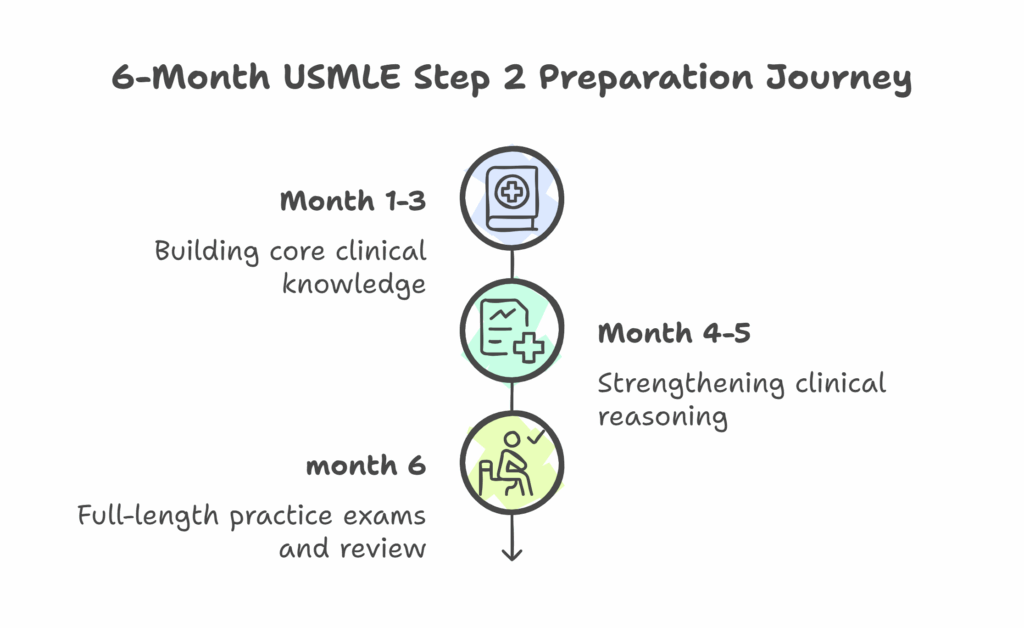

The USMLE Step 2 exam topics are the following:
- Human Development
- Immune System
- Blood & Lymphoreticular System
- Behavioral Health
- Nervous System & Special Senses
- Musculoskeletal System/Skin & Subcutaneous Tissue
- Cardiovascular System
- Respiratory System
- Gastrointestinal System
- Renal & Urinary System & Reproductive Systems
- Pregnancy, Childbirth & the Puerperium
- Endocrine System
- Multisystem Processes & Disorders
- Biostatistics & Epidemiology/Population Health/Interpretation of Medical Literature
- Social Sciences: Legal/Ethical Issues & Professionalism/Systems-based Practice & Patient Safety
6-month USMLE Step 2 preparation plan
In the initial 3 months, concentrate on building a solid understanding of core clinical topics, such as internal medicine, surgery, paediatrics, obstetrics & gynaecology, and psychiatry. Focus on diagnostic reasoning and treatment algorithms for these subjects, and make sure you’re comfortable managing basic clinical cases. Practice daily with UWorld and AMBOSS to familiarise yourself with clinical case scenarios and improve your clinical decision-making skills.
For months 4 and 5, you should focus on strengthening your clinical reasoning by managing complex cases and implementing multi-step patient management strategies. Use your time to apply clinical knowledge in diagnostic & therapeutic contexts, and continue practising USMLE Step 2 test questions with a thorough review of all incorrect answers.
In the 6th month, start doing 1-2 full-length practice exams per week and use the feedback to identify areas for improvement. Concentrate on review sessions for high-yield clinical areas and common patient management scenarios.
USMLE Step 3 exam structure and preparation guide
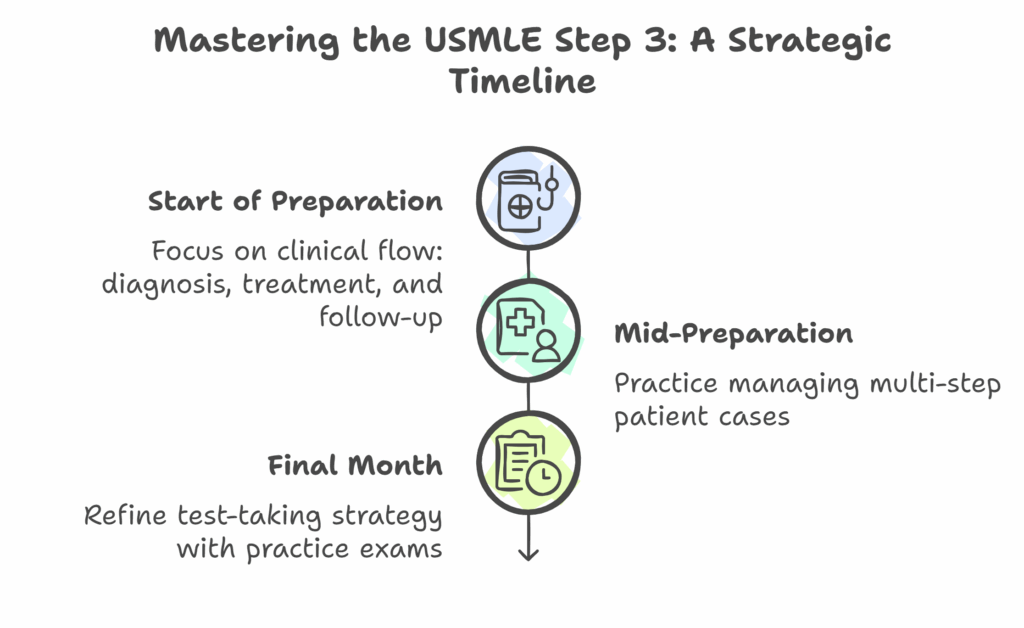

The USMLE Step 3 exam topics are:
- Human Development
- Immune System, Blood & Lymphoreticular System, and Multisystem Processes/Disorders
- Behavioral Health
- Nervous System & Special Senses
- Skin & Subcutaneous Tissue
- Musculoskeletal System
- Cardiovascular System
- Respiratory System
- Gastrointestinal System
- Renal/Urinary & Male Reproductive Systems
- Pregnancy/Childbirth & Female Reproductive System & Breast
- Endocrine System
- Biostatistics & Epidemiology/Population Health & Interpretation of the Medical Literature
- Social Sciences: Communication Skills/Ethics/Patient Safety
USMLE Step 3 prep guide
Step 3 is all about independent patient management, so start off your prep with a focus on mastering the clinical flow: diagnosis, treatment, and follow-up. Practice patient management scenarios and look at long-term care strategies for common conditions like hypertension, diabetes, and heart disease.
Then, focus on applying your clinical knowledge to real-world cases. Practice managing multi-step patient cases, which involve both diagnostic and treatment decisions, as well as long-term follow-up. Work through challenging clinical scenarios and go over the USMLE Step 3 example questions.
The final month should be dedicated to refining your test-taking strategy. Since you’re balancing residency training, try to squeeze in at least 1 full-length practice exam per week. Review all incorrect answers and ensure that you are consistently applying clinical decision-making principles.
By this point, you should be a master at time management and test-taking, and even though Step 3 is touted as the hardest, you will have all your years in education to fall back on when taking the final exam.
USMLE Pass Rates, USMLE Exam Fees & US Residency Match Rates
For a comprehensive overview of the pass rates, recommended scores, fees & US residency match rates, please go over to the What is the USMLE? blog
Why This Matters to You
Choosing the wrong medical school or failing to plan your USMLE preparation correctly could mean years of lost time and resources. Worst case, you might even have to start over or abandon your dream of becoming a doctor in the US altogether.
Imagine spending time and money on a medical school, only to find out that you’re not eligible to sit for the exams or that you don’t have access to the resources you need for a successful match.
To avoid this, you just need to make the right decision the 1st time. Find a medical school that is ECFMG-recognised and gives eligibility to take the USMLE. Even better, opt for a university that will help you achieve your dream.
Take the First Step Toward Becoming a Doctor in the US with the Student Success Programme


If your goal is to become a doctor in the US, it’s best to find a university with a US-aligned curriculum, strong USMLE support, and clinical rotations in the US. However, with an abundance of suitable medical schools, finding the best one can take some serious research.
That’s why we’ve created the Student Success Programme (SSP) as a complete roadmap to becoming a successful doctor anywhere in the world. From finding the best university and securing acceptance to settling in a new location, graduation, and beyond, we’ll be there every step of the way to help you achieve your dream.
Sign up for a free consultation with one of our expert advisors to take the first step toward achieving your dream and becoming a licensed medical professional in the US.
FAQ
Can I take the USMLE if I studied in Europe? Can I take the USMLE if I studied medicine abroad?
Yes, international students can take the USMLE as long as their medical school is recognised by the Educational Commission for Foreign Medical Graduates (ECFMG) and listed in the World Directory of Medical Schools.
What is the best time to start preparing for the USMLE?
It’s best to start preparing for the USMLE from Year 1 or 2 of your medical studies. Early preparation allows you to build a strong foundation and integrate USMLE topics into your regular curriculum.
What USMLE score do international students need to match into a US residency?
While the minimum passing scores are 196 and 214, respectively, competitive scores for international students are typically around 240-250 for Step 1 and Step 2 CK. Strong scores significantly improve your chances of matching into a US residency.
Can I take clinical rotations in the US before taking the USMLE?
Yes, several European universities have partnerships with US hospitals, offering international students the opportunity to complete clinical electives or rotations in the US before taking the USMLE.
How do I register for the USMLE as an international student?
To register for the USMLE, you need to apply through the Educational Commission for Foreign Medical Graduates (ECFMG). After creating an ECFMG account, you’ll submit your medical school documents for verification, complete your application, and schedule your exams.
Which European medical schools are best for preparing for the USMLE?
Several European medical schools offer curricula that align closely with the US medical system, making them ideal for preparing for the USMLE. Some of the best European medical schools for USMLE preparation include Charles University in the Czech Republic and Semmelweis University in Hungary. These schools offer USMLE-focused resources and clinical rotations in the US, which can significantly improve your chances of success.
For a complete list of the top choices, check out The Top Medical Schools in Europe for Americans.
How should I prepare for the USMLE as an international student?
To prepare for the USMLE as an international student, it’s important to start early, ideally in the first 2 years of your medical studies. Focus on mastering the basic sciences in your early years and gradually integrate clinical knowledge. USMLE study tips for international medical students include using resources like UWorld, First Aid, Pathoma, and Sketchy Medical, and practising with question banks regularly. Consider joining study groups and IMG-specific forums for additional study tips and support.
Leave a Reply


About Medlink Students
Leading international recruitment company for medical students in Europe. British Council Certified Agents. 10+ years of experience and more than 10,000 students advised.
